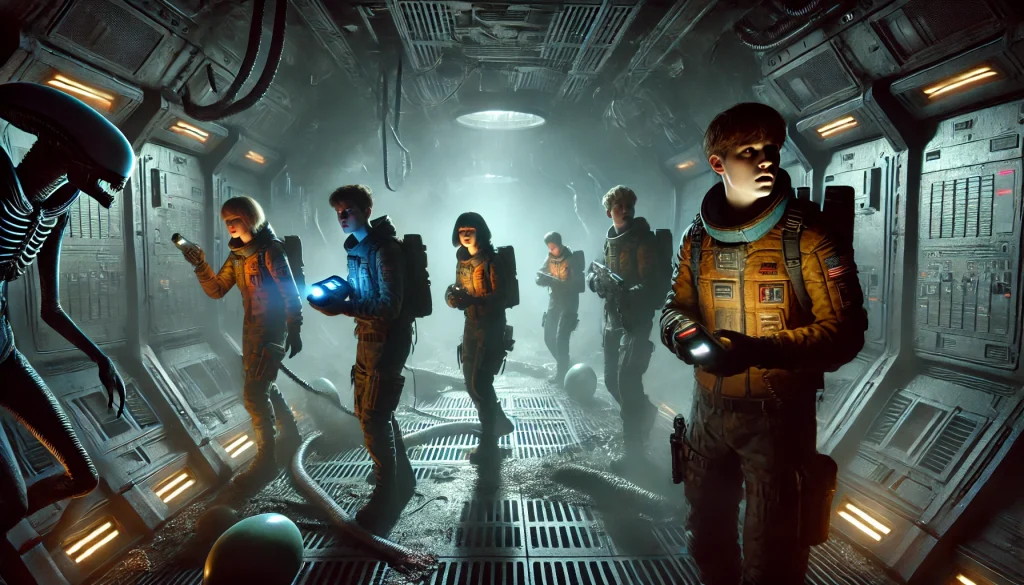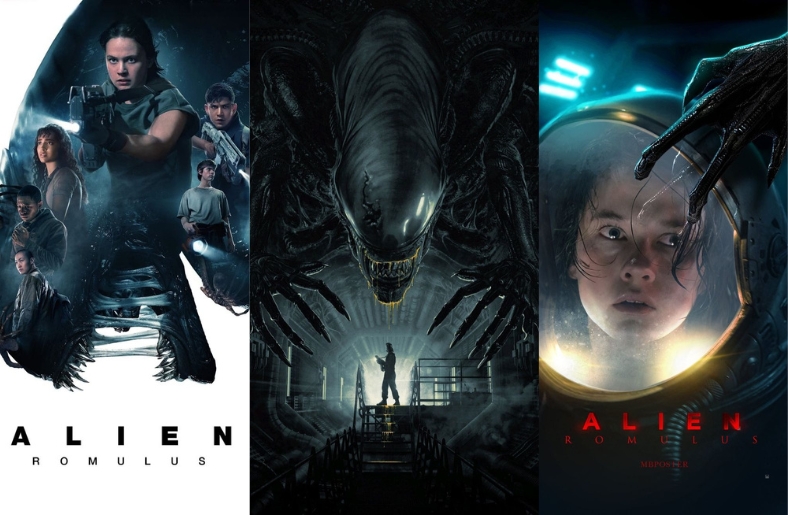Alien: Romulus
| Directed by | Fede Álvarez |
|---|---|
| Written by |
|
| Based on |
Characters
by
|
| Produced by |
|
| Starring |
|
| Cinematography | Galo Olivares |
| Edited by | Jake Roberts |
| Music by | Benjamin Wallfisch |
|
Production
companies |
|
| Distributed by | 20th Century Studios |
|
Release dates
|
|
|
Running time
|
119 minutes |
| Countries |
|
| Language | English |
| Budget | $80 million |
| Box office | $350.8 million |
The much-anticipated Alien: Romulus, written by Fede Álvarez and Rodo Sayagues and directed by Álvarez, represents the latest installment in the now-legendary Alien franchise, notorious for its fusion of science fiction with horror. Alien: Romulus is being produced by Scott Free Productions and Brandywine Productions and falls between the storylines of Alien (1979) and Aliens (1986), inviting the audience into a creepy, visceral experience aboard a deserted space station. Alien: A different level of the complexity within the franchise, as set to the visually rich stage through ensemble cast, along with ties back into the previous lore.
Plot Summary of Alien: Romulus
Alien: Romulus opens on the year 2142 with a Weyland-Yutani probe discovery cocoon in what remains of the USCSS Nostromo. Here, things start unfolding on LV-410, which is described as an ancient, falling-apart colony where poor colonist Rain Carradine is astonished to be told that she has received an extension to her service contract by Weyland-Yutani Corp.
In her desperation to escape, she assembles a group of fellow colonists, which includes her brother Andy (an android reprogrammed by her father), her ex-boyfriend Tyler, and his pregnant sister Kay. Together, they take off on the Corbelan IV for a distant Weyland-Yutani space station called Renaissance in hopes of acquiring cryostasis supplies for a long journey to freedom on the unclaimed planet Yvaga III.
Things become increasingly worse as they continue through the deserted station due to hostile creatures. Thirstily trying to survive against an army of facehugger parasites and xenomorphs, they find all the revolting experiments conducted on it by the previous tenants. Then, in thrilling closure, Rain and crew need to face the raving aliens as the station takes speed toward planetary rings- racing and fighting for survival.
Key Themes and Inspirations
Alien: Romulus brings these themes together, themes of independence versus tyrannical corporation and fear of genetic space experimentation, survival instincts driven by alien threats. Co-director Fede Álvarez, who works off the influence of both Alien and Aliens in this film, makes even more of these motifs working with a new spin of his own. Álvarez also consulted greatly at fan-created wiki Xenopedia in an effort both to pay homage and maintain the existing lore and facts of the franchise.
It is still the representation of some shady Weyland-Yutani Corporation deal, but now added depth in new characters experience issues of identity, autonomy, and desire to be free. Andy-the reprogrammed android-problems of loyalty and identity, along with humanity, raise questions. The fierce determination of Rain to protect her chosen family adds to the core theme of resilience against impossible odds.
Production and Cinematic Techniques
Production for Alien: Romulus was done so that the feeling of the Alien universe-certainly its eerie, claustrophobic ambiance-would not be missed. Budapest provided an interesting setting through which LV-410 and Renaissance would come alive. Production designer Naaman Marshall paid respect to the famous set designs of Ron Cobb from Alien by setting up both practical and CGI environments to give a very realistic, gritty setting.
A nod to the classic Alien look, the movie had used a combination of miniatures, CGI, and practical effects to deliver that immersive visual. The miniature sets for the spaceship Corbelan IV and other similar ones were done by the effects team combining this traditional model work with the modern CGI. The movie also used animatronics for the android character Rook, resembling Ash from Alien, to create this haunting link with the original movie.
Cast and Characters
In the Alien universe, fresh faces abound, and at its forefront stands Cailee Spaeny, playing Rain Carradine. She turns in an excellent performance for the part, capturing well the fragility and grime that Rain embodies. Tyler, Rain’s ex-boyfriend and exasperated protector, is portrayed by David Jonsson. Isabela Merced, playing Kay, is another pregnant and central figure for the movie, adding extra stakes. Archie Renaux, Spike Fearn, and Aileen Wu round out the cast of the survival movie, each providing depth to this survival tale.
The reprogrammed android, Andy, played by Archie Renaux, is a standout character, reminding one of the iconic androids from previous Alien films, with internal conflict and shifting loyalties adding tension. His complex role mirrors the struggles seen in earlier androids in the franchise, which raises questions about autonomy and corporate control.
Cinematic and Visual Effects
Alien: With a budget of $80 million, Romulus is made. The movie boasts visual effects from the most elite studios, including Industrial Light and Magic, Wētā FX, and Tippett Studio. The aesthetic of the film reminds the viewer of the dark industrial style of the original Alien films. The film creates a perfect blend of CGI and practical effects, achieving a realism that modernizes the aesthetic without losing its roots.
Composed by Benjamin Wallfisch, the music weaves in iconic tracks from Alien by Jerry Goldsmith and Aliens by James Horner, building a sense of continuity in the franchise. The haunting soundtrack elevates the film’s tension and atmosphere, with Wallfisch’s score adding layers of suspense and dread.
Marketing and Reception
The Alien: Romulus marketing campaign went amazingly well, engaging audiences to a massive level on the internet. For example, the first trailer attracted almost 50 million views within 24 hours. So, it proves that fans are quite eager for it. Disney also developed special promotional products such as limited-edition Reebok x Aliens shoes and Alien-themed merchandise to further energize the fans.
Alien: Romulus has received mostly positive reviews, praising the suspenseful storyline, the acting, and the special effects. One of the finest actors was Cailee Spaeny in the role of Rain. The cinematography work done by Galo Olivares is great. Critics are mixed in their comments regarding the digital recreation of Ian Holm’s look. Most of them, however, have applauded the movie as the finest addition to the franchise since Aliens (1986).
Alien: Romulus grossed over $350 million at the global box office, making $105.3 million in the United States and $245.5 million abroad. It broke the IMAX horror records and was one of the best-grossing Alien films ever. The powerful opening weekend proved that the Alien franchise was here to stay long and solidified it further as a horror and science fiction franchise.

The Legacy of Alien: Romulus
Alien: Romulus continues the Alien tradition of exploration about the horrors of space and the repercussions of human technological hubris. Fede Álvarez’s installment expands on the legacy established by Ridley Scott and James Cameron, and it presents the thrilling and visually stunning experience that would attract both nostalgic fans and newcomers. It is by expanding on some of Weyland-Yutani’s unethical experiments in its connections to Alien: Isolation, Prometheus, and Alien that the movie takes all of these, putting them together into forming one thrilling journey into the very depths of the Alien universe.
As Alien: Romulus comes out on streaming services and in home media, it is evident that the Alien franchise is as relevant and frightening as ever. This newest addition breathes new life into the franchise but also sets the path for stories in one of the most beloved worlds of sci-fi horror. To the fans of the Alien franchise, Romulus is a chilling reminder to fear what lies beyond the stars.
